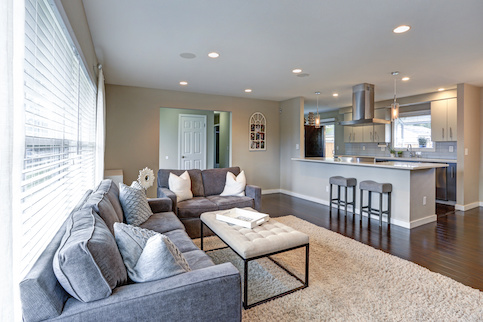13 First-Time Home Buyer Tips

Buying a house is exhilarating yet confusing for first-time home buyers. It’s an exciting yet intricate process, demanding careful consideration and strategic planning as you tour homes and cast a vision of the future. However, getting to the closing table can be a challenge, especially for inexperienced buyers.
The following first-time home buyer tips can bring you closer to the place you’ll soon call home. You’ll learn how to build your credit, navigate the intricacies of mortgages, and hone your negotiation skills, illuminating the path towards your own piece of the American Dream.
First-Time Home Buyer Tips For Preparing To Buy
From finding the right real estate agent to nailing down terms in a negotiation, buying a home for the first time involves dozens of complex moving parts. This list of tips will help you stay focused on the next step and prepare for challenges down the road.
1. Check Your Credit
A strong credit score is one of the major keys in the home buying process because lenders use it to determine your creditworthiness. Specifically, better credit scores help you obtain a lower interest rate on your mortgage. In addition, lenders might refuse to work with you if your credit score is below 580.
The ideal credit score to buy a house is 620 or higher, though it may still be possible to get certain loans with a score as low as 580 – or 500 for some lenders. Reaching this target can be challenging, but you can improve your credit score within months with the following strategies:
- Become an authorized user on someone else’s credit card account if you don’t qualify for credit
- Pay off your credit every month or keep your balances low
- Pay your bills on time
- Take out a credit-builder loan
- Check your credit report for errors
2. Pay Down Debts
Your debt-to-income ratio (DTI) indicates your ability to manage a new loan. A lower DTI is preferable, as it indicates you have more financial capacity to take on a mortgage. Most lenders prefer a DTI of 43% or lower from home buyers.
Eliminating debts from your budget can reduce your DTI and improve your chances of getting approved for a mortgage. For instance, paying off a lingering credit card balance or personal loan can benefit your DTI because doing so reduces your monthly debt obligations.
It’s recommended to create a budget to track your income and expenses, focusing on reducing discretionary spending and allocating extra funds toward debt repayment. Consider strategies like the debt avalanche method (paying off high-interest debts first) or the debt snowball method (paying off the smallest debts first) to tackle your outstanding balances efficiently.
3. Save For A Down Payment And Closing Costs
A down payment is the lump sum you pay towards the home’s purchase price when you close on the loan. It is a percentage of the purchase price. Conventional loans require a 3% down payment. In addition, you’ll pay closing costs to cover various fees associated with finalizing the sale, such as appraisal fees, title insurance, and legal expenses. These costs range from 3% to 6% of the purchase price. As a result, a $300,000 home will require at least $18,000 for the down payment and closing costs.
This figure can be daunting, but a consistent savings strategy can help you reach it. For example, you can open a new high-yield savings account specifically for your home purchase funds to keep them separate from your regular spending money. Then, automate a monthly savings deposit to the account and watch it grow over time.
Remember, you typically don’t need a down payment for VA and USDA loans. However, you may need to pay an upfront fee, like the VA funding fee. If you qualify for one of these loan types, they can help you purchase a home with minimal upfront costs.
4. Determine How Much House You Can Afford
Determining how much house you can afford means understanding how much you can spend on your house payment while not overextending yourself financially each month. Remember, buying a house means paying property taxes and homeowners insurance along with your mortgage loan. Therefore, your budget, desired home size, and location will influence what kind of house you can purchase.
A simple way to evaluate mortgage affordability is applying the 28/36 rule to your budget. Specifically, this rule refers to your monthly housing expenses (including mortgage, property taxes, and insurance) not exceeding 28% of your gross income. Second, your total debt payments (including car loans and child support) should not exceed 36%. So, if your pretax monthly income is $7,000, your monthly house payment should be $1,960 or less.
For a more detailed approach, borrowers can use a home affordability calculator to compare their financial capability with current home prices. By factoring in your location, annual income, and credit score, you’ll zero in on an affordable home price matching your circumstances.
5. Finalize Your Wants Vs. Needs
Creating a clear distinction between what you want and need in a home helps you prioritize your preferences and make more focused decisions during the home search. Wants are features or amenities that would be nice to have but are not essential, while needs are non-negotiable requirements. Drafting a wants-versus-needs list helps first-time home buyers in the following ways:
- Ensures you purchase a property that meets your basic requirements
- Prevents you from overspending on unnecessary features
- Streamlines the home search process by providing a clear framework for evaluating properties
- Narrows your options and prevents the home search from becoming overwhelming
- Helps you make more rational choices, reducing the likelihood of being swayed by emotions during the house-hunting process.
- Means that the property you choose will align with your long-term goals and lifestyle
Remember, finding the right house will require some compromises. It’s best to keep an open mind about potential renovations or improvements that meet your needs. In other words, you can look beyond the current state of the property and visualize what features can be changed or added. Additionally, it’s crucial to consult with a real estate agent for insights on which homes meet your needs.
Above all else, the property should satisfy the items on your “needs” list. The house that meets all your needs might not be your dream house, especially if you’re a first-time home buyer. However, your first home is a stepping stone to the next one, and getting into a house lets you start accruing equity and learning the ins and outs of homeownership.
Lastly, the property should align with your financial capabilities. Avoid stretching your budget too thin, as this can lead to financial stress down the line. Remember, if your budget is at capacity with your new house payment, saving for home repairs and other expenses can be challenging.
Home Affordability Calculator
Calculate the home price you can afford using your income and the amount of debt you have.
See What You Qualify For
Home Purchase
Home Refinance
Tap Into Equity
First-Time Home Buyer Tips For Choosing A Mortgage
Here are the strategies first-time home buyers can use to get a mortgage that suits their situation:
6. Compare Multiple Lenders
Not all lenders offer the same terms, interest rates, and fees. It’s crucial to research offers from multiple mortgage lenders to ensure you get the best deal. For example, your current bank or credit union might offer you an exclusive mortgage interest rate because of your existing relationship. Therefore, this process can save you tens of thousands of dollars over the life of your mortgage.
Remember, various institutions compete in the mortgage lending market, including banks, credit unions, fintech providers, and online lenders. So, it pays to gather quotes from several lenders to get favorable loan terms, interest rates, and closing costs.
7. Consider Different Loan Options
Similar to your lender options, various types of home loans are available. Each has unique features, interest rates, and down payment requirements. Understanding the different options will help you choose the one that best fits your financial situation and long-term goals:
- Conventional loan: These home loans come from private lenders and don’t have government backing. As a result, you’ll need a credit score of 620 or higher, DT) ratio under 50%, and a 3% minimum down payment to qualify. In addition, borrowers must pay private mortgage insurance (PMI) premiums along with their mortgage if their down payment is less than 20%.
- Federal Housing Administration (FHA) loan: FHA loans have backing from the federal government. This feature reduces the risk for lenders, so borrowers with a credit score as low as 500 can qualify. However, this score necessitates a 10% down payment. On the other hand, a credit score of 580 and above allows you to put 3.5% down. Remember, you’ll also pay mortgage insurance premiums (MIP) for the life of the loan if your down payment is less than 10%.
- U.S. Department of Agriculture (USDA) loan: A USDA home loan is a mortgage for low-income individuals living in rural areas. These loans have government backing and provide borrowers with interest rates as low as 1% when modified by payment assistance. In addition, lenders typically don’t require a down payment.
- Department of Veterans Affairs (VA) loan: VA loans are mortgages for veteran and active duty military members and their eligible surviving spouses. These loans have lower interest rates than conventional mortgages, minimal credit requirements, relaxed DTI standards, and no down payment requirement.
8. Get Preapproved
Getting preapproved for a mortgage gives you a clear understanding of how much you can borrow, which can help you narrow down your home search to properties within your budget. It demonstrates to sellers that you are a serious buyer and reduces the chance of your financing falling through when you’re under contract with a seller.
9. Consider First-Time Home Buyer Programs
Many governments and organizations offer first-time home buyer programs to increase the affordability of homeownership. For instance, you can enroll in a regional home buyer education class that awards those who complete the course with financial assistance. In addition, down payment assistance may be available to defray the steep upfront cost of homeownership. Lastly, Fannie Mae offers first-time home buyers who make 100% or less of the local median income a 3% closing cost credit when buying a HomePath home.
First-Time Home Buyer Tips For Purchasing A House
Once you have financing in place, it’s time to hit the market. These tactics will help you put your best foot forward when looking at homes and submitting offers:
10. Work With A Real Estate Agent
Hiring a real estate agent or REALTOR® is an invaluable step for first-time home buyers. These professionals can guide you through the home-buying process, provide crucial insights, and help you find properties that meet your criteria. They have access to a wide range of listings, can arrange appraisals and inspections or negotiate on your behalf. They also have a deep understanding of local real estate markets. Plus, agents are experienced in handling the extensive paperwork and legal aspects of a real estate transaction, ensuring closing goes correctly.
11. Learn How To Negotiate
Negotiation tactics are essential to making an offer on a house effectively. They can help you edge out the competition in the current red-hot real estate market. Specifically, it’s advisable to offer above the asking price, give an appraisal guarantee, apply minimal contingencies, and submit a large earnest money deposit to get the seller’s attention.
12. Get A Home Inspection
A home inspection is a thorough examination of the property’s condition by a qualified inspector. It helps identify any potential issues or needed repairs before finalizing the purchase.
When you hire a licensed and experienced inspector, they’ll walk through the entire property and provide a detailed report covering all aspects of the property, from structural integrity to electrical systems. Uncovered issues can give you negotiating power or a valid reason to back out of the deal if you have a contingency in place.
13. Buy Homeowners Insurance
Homeowners insurance is a policy that provides financial protection in case of damage to your home, personal belongings, or liability for injuries or property damage to others while on your property. Coverage includes incidents like fire, theft, vandalism, or natural disasters.
Furthermore, mortgage lenders require borrowers to have homeowners insurance as a condition for approving the loan. Because the property is collateral for the mortgage, lenders require its protection in case of damage or loss.
The Bottom Line
Embarking on the journey of buying your first home involves a series of critical steps and decisions. From assessing your financial health, managing debts, and saving for a down payment to understanding mortgage options and enlisting professional help, each stage plays a pivotal role in securing your dream home.
With careful planning, thoughtful consideration, and the right professional support, you’ll be well on your way to finding a place you can truly call home. You can start a mortgage application today to be one step closer to homeownership.
Home Buyer’s Guide
Follow our step-by-step guide to learn how to buy a home.











